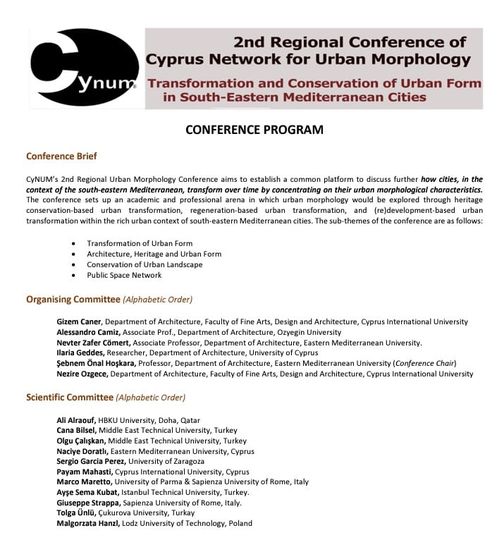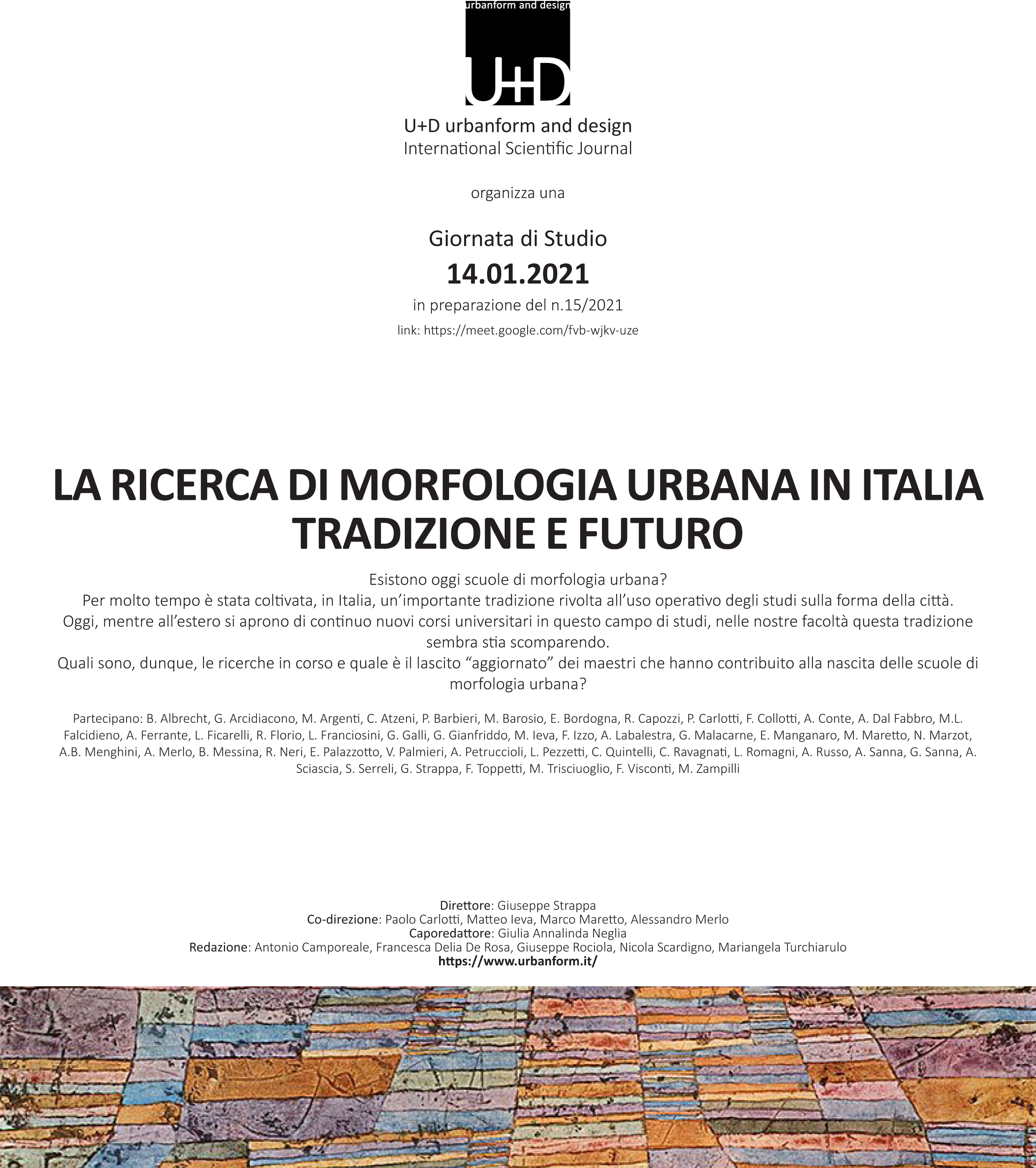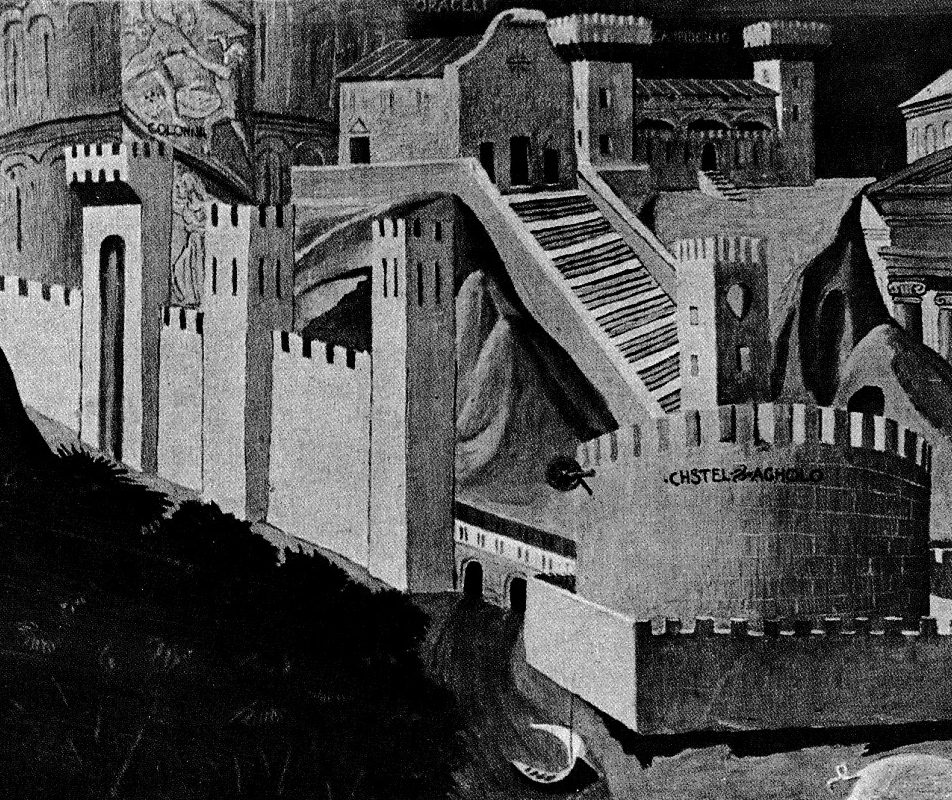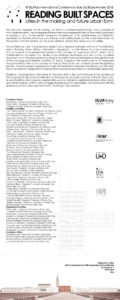“Landscape and urban form”

ISUF Conference 2008
ISUF will hold an international conference in Artimino, next to Florence, Italy, into the XVI century Medicean Villa, on 21, 22 and 23 of November. The broad theme of the conference will be “Landscape and urban form”. It is hoped that the conference will showcase current research and practice in urban morphology in relation to different international centres.
Urban Morphologists wishing to present a paper at the conference should contact Professor Gianluigi Maffei, Florence Faculty of Architecture, Department of Architectural Design, Viale Gramsci n°42, 50132 Firenze (e-mail: gianluigimaffei@libero.it). Proposals should have the following format: name of author(s), affiliation, postal address, e-mail address, telephon number, fax number, title of paper and an abstract of about 250 words. The deadline for the receipt of proposals is 1 July 2008.
The number of places at the conference will be limited and acceptance for attendance will be on a first come, first served basis. Placement on the programme will be communicated to applicants by 15 July 2008, and will be contingent upon advance registration. Details are available on ISUF’s website (www.urbanform.on) from 1 of April. Definitive papers should be submitted by 15 of September 2008.
The next meetings of ISUF’s Council and Editorial Board will take place during the conference. Any matters that members wish to bring to the attention of the Secretary-General, Prof. Nicola Marzot, should be communicated to him by e-mail at studioperforma.marzot@email.it (postal address: Faculty of Architecture, University of Ferrara, Via Quartieri n°8, 44100 Ferrara, Italy)
conference program
FRIDAY 21
2.00 – 4.00 p.m. – Registration
4.00 – 5.15 p.m. – UM Editorial Board (Members only:
Room B)
5.15 p.m. – Welcome Coffee
– Inauguration of the Exhibition “Carmignano, its Territory and its Settlements”
5.15 – 6.30 p.m. – ISUF Council (Members only: Room B)
ROOM A
6.30-7.00 p.m. – Welcome remarks
– Doriano Cirri, Mayor of Carmignano
– Ulisse Tramonti, Director of Dipartimento di
Progettazione dell’Architettura, Università di Firenze
– Gian Luigi Maffei, President of ISUF
– Alessandro Merlo, President of CISPUT
7.00-7.45 p.m. Keynote lecture:
Urban forms and landscape: hard times, new issues?
Pier Giorgio Gerosa, Ècole Nationale Superieure
d’Architecture de Strasbourg, Strasbourg, France
8.30 p.m. – Dinner
SATURDAY 22
ROOM A
9.00-9.45 a.m – Keynote lecture:
Through the French urban landscape, and what can we find there
Michaël Darin, Ècole Nationale Superieure d’Architecture de Versailles, Versailles, France
ROOM B
9.45-10.45 a.m. – Chair: Jeremy Whitehand
Malignant land use/cover expansion in human communities
Warren M. Hern, Departement of Anthropology, University
of Colorado, Boulder, Colorado, USA
Planned cities and landscape: historic cases in Finland
Marjut Kirjakka, Helsinki, Finland
ROOM C
9.45-10.45 a.m. – Chair: Nicola Marzot
Inherited urban forms and the challenge of the twenty first century
Jorge Ricardo Ferreira Pinto, Faculdade de Letras da Universidade do Porto, Porto, Portugal
The urban spatial cycles related to economic cycles. Theoretical base for empirical research
Rozana Rivas de Araújo & Maria Alice Lahorgue, Universidade Federal do Rio Grade do Sul, Porto Alegre, RS, Brazil
10.45 a.m. – Coffee break
ROOM B
11.00-12.00 a.m. – Chair: Jeremy Whitehand
Urban Morphology and landscape concepts as instruments for planning practices
Staël de Alvarenga Pereira Costa, Escola de Arquitetura, Departamento de Urbanismo, Universidade Federal de Minas Gerais, Belo Horizonte, MG, Brazil
Fringe belts and Green belts
Sigridur Kristjansdottir, Agricultural University of Iceland, Borgarnes, Iceland
ROOM C
11.00-12.00 a.m. – Chair: Nicola Marzot
New paradigms for the contemporary landscape: environmental planning and urban form in an Amazon town
Paolo L. Codo Dias & Lucia Capanema Alvares, Universidade Federal de Minas Gerais, Belo Horizonte, MG, Brazil
Crisis and new opportunities of Sardinian rural landscapes
Adriano Dessì, Dipartimento di Architettura – Università degli Studi di Cagliari, Cagliari, Italy
12.30 p.m – Lunch
ROOM A
2.30-3.15 p.m. – Keynote lecture:
How growing cities internalize their old urban fringes
Michael Conzen, Committee on Geographical Studies, University of Chicago, Chicago, IL, USA
ROOM B
3.15-4.45 p.m. – Chair: Staël de Alvarenga Pereira Costa
Spatial culture related to the private and public planning of Aracaju (1855-2003)
Eder Donizeti da Silva & Adriana Dantas Nogueira, Federal University of Sergipe, Aracaju, Sergipe, Brazil
Detailed plan of the historical center: in the merit of the historical urban fabric
Pico Farnese
Paolo Carlotti, Facoltà di Architettura, Politecnico di Bari, Bari, Italy
The urban legislation and morphology of Moema (São Paulo, Brazil)
Denise Antonucci, FAU, Universidade Presbiteriana Mackenzie, São Paulo, SP, Brazil
ROOM C
3.15-4.45 p.m. – Chair: Shigeru Sato
Mapping Urban Symbolic Order
Ana Paula Polidori Zechlinski & Romulo Krafta, Federal University of Rio Grande do Sul, Porto Alegre, RS, Brazil
A methodology for eliciting the public multi-sensory image of urban open spaces
Paula Barros, Oxford Brookes University, Belo Horizonte, MG, Brazil
Landscape and urban form. Linguistical components of settlement types
Mario Gallarati, Studio Architettura Gallarati, Genova, Italy
4.45 p.m. – Coffee break
ROOM B
5.00-6.30 p.m. – Chair: Staël de Alvarenga Pereira Costa
Sustainable transport modes: a solution of transport dilemma in Auckland
Ning Huang & Robert Vale, School of Architecture and Planning, University of Auckland, Auckland, New Zealand
Disperse Urbanization in Região dos Lagos: a case study
Gabriela Campos, Michele Coyunji & Werther Holzer, Universidade Federal Fluminense, Niterói, RJ, Brazil
The international influences on the planning of Abuja, the new capital of Nigeria
Jurgen Lafrenz, Universitat Hamburg, Hamburg, Germany
ROOM C
5.00-7.00 p.m. – Chair: Shigeru Sato
The concept of ‘Cultural Region’. Between landscape and urban form: the Emilian case-study
Marco Maretto, Dipartimento di Ingegneria Civile, dell’Ambiente, del Territorio e Architettura, Facoltà di Architettura, Università degli Studi di Parma, Parma, Italy
A study on the interaction between town layout and nature: the urban landscape of Maringá, Brasil
Karin Schwabe Meneguetti & Renato Leão Rego, Departamento de Arquitetura e Urbanismo, Universidade Estadual de Maringá, Maringá, PR, Brasil
Village-scape and morphology: a study on Chinese historic villages
Sheng Ying, Shanghai Tongji Urban Planning & Design Institute, Shanghai, China
Urban morphology and planning: exploring the fringe-belt concept in Auckland, New Zealand
Kai Gu, School of Architecture and Planning,
University of Auckland, Auckland, New Zealand
8.00 p.m. – Gala dinner
SUNDAY 23
ROOM A
9.00-9.45 a.m – Keynote lecture:
The concept of territory of the Muratorian school
Attilio Petruccioli, Facoltà di Architettura, Politecnico di Bari, Bari, Italy
ROOM B
9.45-10.45 a.m. – Chair: Giuseppe Strappa
Lhasa: urban morphology in transit
Amund Sinding-Larsen, Norwegian University and Science, Trondheim, Norway
Iugeral models for the park of the aquaeducti aniensi: a new archaeological restraint. Castel Madama (Rome) Italy
Alessandro Camiz, Università di Roma ‘La Sapienza’, Facoltà di Architettura ‘Valle Giulia’, Roma, Italy
ROOM C
9.45-10.45 a.m. – Chair: Michael Barke
The morphological aspects of the construction of Lisbon’s landscape territory: Urban Form vs. Cultural identity in the county of Cascais
Maria Amelia Cabrita & Teresa Marat-Mendes, ISCTE, Department of Architecture and Urbanism, Lisboa, Portugal
Urban landscape and the new suburbs in Rio de Janeiro, Brazil
Maria Marta dos Santos Camisassa, Universidade Federal de Vicosa, Vicosa, MG, Brazil
10.45 a.m. – Coffee break
ROOM B
11.00-12.30 a.m. Chair: Giuseppe Strappa
The mediterranean city of Parga in Epyro, process of development from the past to the future next
Marilena Novelli & Enrico Genovesi, Facoltà di Architettura L. Quaroni, Università ‘La Sapienza’, Roma, Italy
Contemporary urbanism and urban morphology in the cities of north of Portugal (1852-1926)
Mário Gonçalves Fernandes, Departamento de Geografia, Faculdade de Letras da Universidade do Porto, Porto, Portugal
The transformation of the urban tissue in the Tetrarchy imperial residencies
Giacomo Gallarati, Facoltà di Architettura, Genova, Italy
ROOM C
11.00-12.30 a.m. – Chair: Michael Barke
Transformation coastal process along the ‘Salpi’ Lagoon. From the Urban structure of Margherita di Savoia to the develop of the agricultural housing on the sand bar
Giuseppe Francesco Rociola, Politecnico di Bari, Bari, Italy
Afonso Pena Avenue: between the creek and the mountain range
Bernardo Nogueira Capute, Camila Marques Zyngier & Paula Balli Cury, Belo Horizonte, MG, Brazil
Reading-study and project for the historical centre of Castel Madama (Rome, Italy) and its territory
Alessandro Franchetti Pardo, Università di Roma ‘La Sapienza’, Facoltà di Architettura ‘Valle Giulia’, Roma, Italy
ROOM A
12.30-1.30 p.m. – President: Gian Luigi Maffei
ISUF general meeting and conclusion
1.30 p.m. – Final lunch




